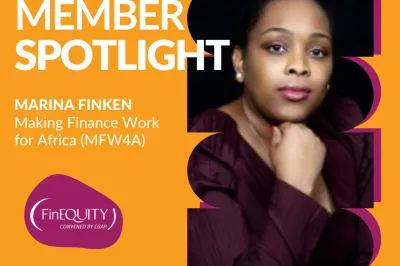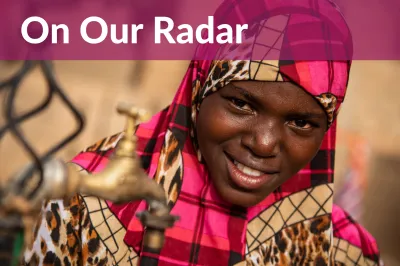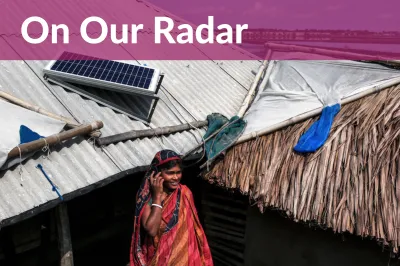Diagnostic: Female Livelihoods in the Gig Economy

This blog post was originally published on the Caribou Digital blog.
Diagnostic is a series of essays and hosted conversations exploring the challenges of building more inclusive Digital economies. For hosted (virtual) conversations, like the one described below, Caribou Digital convenes a diverse set of experts and thought leaders with unique insights on an issue, and facilitates the exploration of a topic together.
For this conversation, we had 12 experts on women and platform work in emerging markets, ranging from those running platforms to donors, private sector, academia and advocacy. The conversation was under Chatham House rules so this is an edited summary of the key themes and not attributed to any one person. However, we have a list of names and resources discussed at the end of this piece.
What’s the landscape in a COVID-19 world?
As we began our Diagnostic discussion, we acknowledged that COVID-19 illustrated the worst case scenario for many platform workers, and even more so for women. Research by Caribou Digital and Qhala in partnership with Mastercard Foundation has shown that platform work for women holds many tensions, and this has been further heightened by the lack of a safety net during COVID-19. The myth of flexible work may in many cases be no more than cheap labor in disguise, and self employment a way for employers to shift responsibility to workers. This can impact women more so than men. COVID-19 also brought home the reality (perhaps obvious) that women still carry most of household duties while also working, another flip side of flexibility which puts more strain on women trying to combine both kinds of work.
Below, we distill our discussion into three tensions, three actions and the way forward on women and platform work, especially in emerging economies.
The tensions of formal, flexible work
On the one hand, the formality of platforms was seen as a plus point. Being given an identity (e.g. a badge, a relationship) was something women valued, according to one platform provider. It had a similar appeal for the customer: “I think, people use a platform rather than go the traditional way for the responsibility a platform always takes. The way Uber verifies rides, indemnifies any problems users face and takes users’ feedback seriously…every platform should take the responsibility of ensuring a digital identity, verifying ID cards and including for finance”. However, too many restrictions have made platform work unfair. A report on Kenya, for example, showed that drivers were “worse off” after the introduction of Uber. Platform lock-in can also be disadvantageous to the worker (for example, when a woman works across different companies or platforms… shouldn’t they be able to have ownership over their identity and ratings)?
Equally, in theory, platforms provide an opportunity for women’s emancipation, notably by providing “flexible” work, i.e. flexible hours, working from home etc. Yet, even pre-COVID, many platforms fell short of protecting their workers. Now, the flexibility benefits of platform work, especially for women, are being questioned, as a kind of “bogus self-employment”. From a gender perspective, real change is unclear. One participant stated that “platforms do nothing to change the gendered occupational segmentation that characterizes offline labor markets around the world”.
Building identity…or having to fake it
What do platforms do regarding workers’ sense of identity? On the one hand, platforms provide a sense of identity and belonging: “helpers are motivated to work on HelloTask’s platforms because of the identity they get on our platform rather than working like a ghost.” On the other hand, workers can fake their identity to counter the racial or gender biases that exist on platforms. For example, some female workers in Kenya were adopting “white, male” identities to get (more) work, depending on the type of work. In some sectors, being a woman will be preferred, (e.g. beauticians, domestic work). So how much does one need to identify oneself?
Broad reach versus high-tech
Despite this significant opportunity for women’s emancipation mentioned above, how can we ensure we move beyond only higher skilled women having the opportunity for digital work? One study mentions the increasing integration of social commerce for female-headed small and medium enterprises. However at the same time the risk of “too much tech” was brought forward — with a large part of potential gig workers (the “jua kali” type workers, as described in Kenya’s informal economy) not being digitized, not having smartphones let alone computers. Women are particularly affected by the digital gap, often only accessing feature phones and either unable to participate or participating through intermediaries, for example giving someone else’s contact number or bank account for payment, which increases the risk of dependence.
What are the priority actions and who is responsible for them?
Making platforms accessible to all — including the lower income and often unemployed communities, especially women was one of the key points. How to ensure that inclusion and who is responsible for it is a harder “hot potato” question. We agreed that platforms had a significant role to play, in some cases along with funders/investors, regulators/policy bodies, workers themselves and workers’ organizations.
More feature phone integration
One way of encouraging scale and inclusion is by integrating basic feature phone access to platform services. For example HelloTask used IVR to connect with domestic workers when there is a job for them as they rarely had smartphones. Similarly, using SMS and USSD services is key to ensuring platforms reach all workers — including at the last mile. However, there was skepticism on interest and investor funding on this: “I wonder what chances you’d get in 2020 at getting funding for an SMS-based service when most money seems to be drawn to the web and apps”.
Address analogue gaps such as ID
Women are particularly at risk of not having their own ID credentials resorting to their family’s ID (often father/brother) which raises a first question as to whether platforms can change the existing informal power relationships or do they leave them unchanged. Intertwined with ID requirements are payments and financial inclusion as not having an ID may often lead women to being financially excluded. Platforms’ payments structures often do not favor workers: “wage management and payment processes are set up for the convenience of the “employers” who are upper/middle class clients.” This not only limits access but also impacts on other issues such as credit scoring or financial independence. Platforms and digital financial service providers could push for these types of processes to be put in place.
Invest in education and training
Education and training of workers is required to ensure that they can fully leverage the opportunities platforms provide — especially in order to get more skilled and better paid gig work online. Currently, to fill the existing training and knowledge gaps, workers organically regroup on social media platforms to create self-help groups. However this may not be sufficient and women may not have the time or possibility to join these groups in the first place.
Platforms seem to take on the responsibility of trust in the worker for the customer’s sake (e.g. vetting a domestic helper) but not necessarily being responsible for the worker’s health and safety or their training: “platforms avoid training as it can be used for a claim that they have misclassified independent contractors as employees/workers…this is why algorithmic control is preferred to explicit methods of control / direction / training in many cases.”
The way forward
As a group, we agreed that all stakeholders had a responsibility, especially platforms themselves — be it in training or security. Platform work should not just be work but meaningful and dignified work. This is obviously not just an emerging markets issue. Governments around the world — the Canadian government was mentioned as an example — and regulators do not always seem to know what to do as this is still a nascent area. As a whole, we could devise metrics on women’s inclusion and safety on platforms (see the work of the Fairwork Foundation for example). One suggestion was that: “development agencies and investors could play the role of the regulator to ensure certain metrics are met when it comes to ensuring gender parity.” Worker rights movements or organizations, women’s rights bodies and unions could exert pressure. Private bodies such as Perks could also create sustainable models for gig workers’ benefits for safety nets and guidance on how to ensure that platforms provide decent work to workers, in particular women. In short, there is still much work to be done on women and platform work worldwide, including in emerging markets.
Participants
- Anjali Banthia, Tala
- Dr. Jamie Woodcock, Open University, https://www.jamiewoodcock.net
- Jessica Colaço, Brave Venture Labs
- Dr. Kathi Kitner, Payments, Google
- Katie Highet, FinEquity, convened by CGAP
- Ken Banks, Yoti
- Mahmudul Hasan Likhon, HelloTask
- Rani Deshpande, CGAP
- Shikoh Gitau, Qhala
- Shirley Mburu, BFA Global
- Shyam Krishna, Royal Holloway, University of London
- Dr. Tricia Williams, Mastercard Foundation
Other participants chose to remain anonymous.


